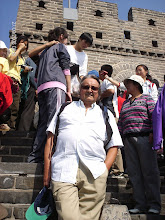
It is said that Spissky is the biggest surviving (although ruined) castle of Central and Eastern Europe. So, I ought to visit it. Especially that the first time I passed on the area, going from Levoca to Presov, I passed not far - but at the time I was not yet a fan of WH. The second time, touring the North of Hungary by car, I decided I should not miss Spassky Hrad and took a detour to Slavakia; the two countries were freshly EU members, but not yet "Schengenland" ones, so the border checks were in place, but on a relaxed mood.
At a curve of the road Spissiky Hrad appeared in the distance, bravely on top of a big hill. I stopped at Spissky Kapitula, the nearby small town, just down the hill; here you have fine views of the Hrad from an underneath position. Then I proceeded to the castle. Being in such a proeminent position, I could devise (it was a fine Summer day) the Tatra mountains in the distance. I took my time to stroll around the castle and also to walk outside its precinct on the grassed slopes around it.
Later I drove back to Hungary, via Kosice, and stopped for dinner and sleep at Tokaj, the town of the country's famed sweet wine. The next morning I walked on town and climbed up the vineyards on the hills follwing a copious hungarian-style breakfast - on a happy mood, having added two more WH sites to my personal "collection". Sadly on that evening Portugal was to loose the final of the football Euro 2004 championship. Life is never as perfect as one hopes!


















